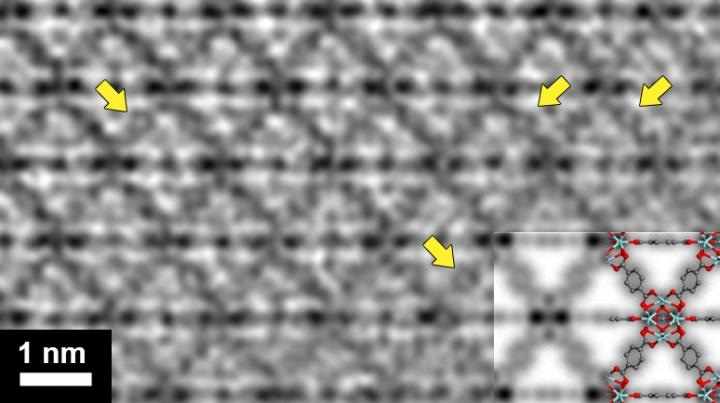Jan 19 2018
Scientists from the King Abdullah University of Science and Technology (KAUST) have developed a new technique for obtaining atomically resolved images of beam-sensitive materials by adopting transmission electron microscopy. Daliang Zhang, Rachid Sougrat, and Kun Li from the KAUST Core Laboratories, in collaboration with Professor Yu Han and team members Yihan Zhu, Lingmei Liu, Xiangrong Ying, and Chia-En Hsiung, have reported their outcomes as a first release January 18, 2018, in the Science journal.
 CTF-corrected high-resolution TEM image from a MOF UiO-66 crystal. The benzene rings in the crystal are indicated by arrows. Overlays are simulated projected potential map and structural model for comparison. (Image credit: KAUST)
CTF-corrected high-resolution TEM image from a MOF UiO-66 crystal. The benzene rings in the crystal are indicated by arrows. Overlays are simulated projected potential map and structural model for comparison. (Image credit: KAUST)
“High-resolution imaging of electron beam-sensitive materials is one of the most difficult applications of transmission electron microscopy (TEM). The salient challenges are the acquisition of images using extremely low electron doses, the time-constraint inherent in the search for crystal zone axis prior to the sample being damaged, precise image alignment and the accurate determination of the defocus value,” elucidated Han.
The technique developed at KAUST to satisfy these demands has been demonstrated by obtaining atomic-resolution TEM images of various metal organic frameworks (MOFs) and other similar beam-sensitive materials, “reducing this procedure to a near-routine process,” stated Li.
Despite the fact that high-resolution TEM (HRTEM) is a dynamic tool for characterizing structures, it is not simple to use this tool in the case of electron-beam-sensitive materials such as MOFs, which mandate ultra-low doses of electrons to stay unaffected. The latest advancement of direct electron detection cameras has enabled researchers to obtain an image in ultra-low dose mode, that is, only a few electrons per square angstrom. However, the capabilities of such a camera for performing HRTEM imaging of electron beam-sensitive materials is still restricted by the hindering barriers: sourcing of a zone axis, aligning of images, and ascertaining a precise defocus value.
“Our team at KAUST first developed an algorithm enabling us to achieve a one-step alignment of the zone axis while keeping the specimen intact. Unfortunately, due to inherent issues when dealing with beam-sensitive materials, HRTEM would still produce blurred images mainly due to sample drift during exposure. To overcome this, a series of successive short exposures were taken. These, however, resulted in very noisy frames. An amplitude filter technique was developed to minimize noise and accurately align all the frames.”
Professor Yu Han
Moreover, in order to reconstruct the structure, the researchers devised a process by tapping the instability of beam-sensitive materials to ascertain the absolute defocus value from the deliberately amorphized region.
These procedures, devised at KAUST and incorporating two provisional patents, are not only restricted to beam-sensitive materials. The technique for aligning the zone axis is also specifically relevant for aligning nanosized crystals, and the process for aligning the image can be usually applied to correct noisy images including periodic features.
This seminal paper has not only significantly broadened the applications of HRTEM, but it has also provided the beam-sensitive materials researchers with a powerful tool capable of investigating the structure of beam-sensitive materials in much more localized detail than traditional X-ray diffraction techniques permit. This will undoubtedly facilitate beam-sensitive materials researchers in the designing of new structures with enhanced performance.
Kun Li